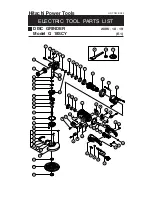
ENGLISH
en
11
Connect a FI circuit-breaker with max.
release current (30 mA) upstream when using the
machine outdoors!
Pull the plug out of the socket before making any
adjustments, converting or servicing the machine.
A damaged or cracked additional handle must be
replaced. Never operate a machine with a defective
additional handle.
A damaged or cracked hand guard must be
replaced. Never operate a machine with a defective
hand guard.
See page 2.
1 Button for adjusting the hand guard
2 Hand protection
3 Press in the spindle locking button only when
the spindle is stationary
4 Sliding on/off switch
5 Additional handle / Additional handle with vibration
damping *
6 Speed adjustment wheel
7 Electronic signal indicator
8 Adjusting nut
9 Accessory
10 Support flange
11 Spindle
12 Allen key
13 2-hole spanner
* depending on equipment/not in scope of delivery
Before plugging in, check that the rated mains
voltage and mains frequency, as stated on the
rating label, match with your power supply.
6.1 Attaching the additional handle
Always work with the additional handle
attached (5)! Attach the additional handle on
the left or right of the machine and secure.
6.2 Attaching the hand guard
Always work with the hand guard (2) attached.
Inserting:
- Press and hold the button (1).
- Slide the hand guard (2) into the slot from the
bottom to the top as shown (see illustration a,
page 2). First slide the glider with the widest
diameter approx. 5 mm into the external slot. Then
slide the glider with the smallest diameter into the
inner slot.
Note: Do not try to slide both gliders into both slots
at the same time, as this will not work. Start with
the external glider, and the inner glider will follow
automatically.
Turning:
- Press the button (1) and turn the hand guard until
the closed section is facing the operator.
- Make sure that the guard is securely positioned:
The button (1) must engage and you should not be
able to turn the safety guard.
Disconnect the mains plug before changing
any accessories. The machine must be
switched off and the spindle at a standstill.
7.1 Positioning the accessory
See illustration b, page 2.
- The two sides of the support flange (10) are
different: Place the support flange (10) around the
spindle (11) in such a way that the large collar
diameter which corresponds to the accessory (9)
is facing upwards.
- Place the accessory (9) on the support flange
(10). The accessory must lay flat on the
supporting flange.
7.2 Tightening/loosening the clamping nut
Securing the clamping nut (8):
The 2 sides of the clamping nut (8) are different.
Screw the clamping nut onto the spindle (11) as
follows:
-
A) In the case of thick (6 mm) accessories:
The collar of the clamping nut (8) faces
downwards so that the clamping nut can be
attached securely to the spindle.
B) In the case of thin (3 mm) accessories:
The collar of the clamping nut (8) faces upwards
so that the thin accessory can be clamped
securely.
- Lock the spindle (11) using the Allen key (12).
Tighten the clamping nut (8) by turning it
clockwise using the 2-hole spanner (13) (see
illustration c, page 2).
Releasing the clamping nut:
- Lock the spindle using the Allen key (12). Remove
the clamping nut (8) by turning it anticlockwise
using the 2-hole spanner (13) (see illustration b,
page 2).
8.1 Setting speed
The speed can be preset via the setting wheel (6)
and is infinitely variable.
5. Overview
6. Initial Operation
7. Attaching the accessory
8. Use
7
A
7
B












































